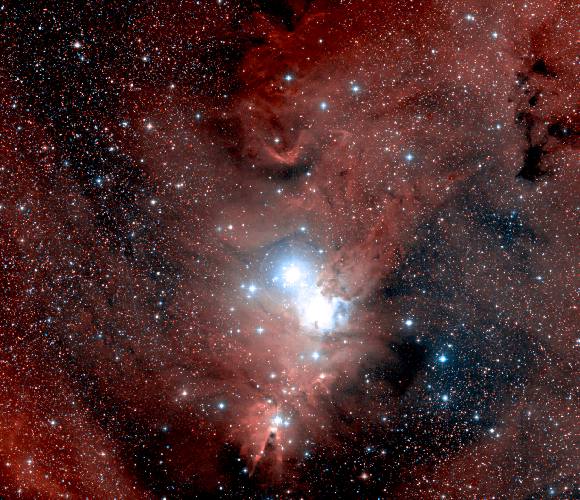
The Cone Nebula. Image size: 1.7°x1.5°. DSS image. © CalTech/Palomar
The Cone Nebula is a famous nebula in the Orion Arm surrounding the NGC 2264 star cluster. The 'cone' is a triangular dark nebula near the bottom of the nebula. The bright star at the centre of this picture is 15 Monocerotis (or 'S Monocerotis') - it is a quadruple star system consisting of four brilliant blue-white stars (classes O7, B7, B8 and A6) and it is partly responsible for causing the nebula to glow.

Below is a list of the main nebulae to be found in this region. The Cone Nebula (NGC 2264) is the main nebula - it is the brightest part of a large emission nebula and it is the only nebula in this list with an accurate distance. The distances to the other nebulae in this list are very uncertain. IC 446 and NGC 2245 seem to be several thousand light years behind the Cone Nebula, all of the other nebulae could be associated with the Cone Nebula.
1 2 3 4 5 6 7 8
Catalogue Equatorial Galactic Size Type Distance Size Other Names
Number Coordinates Coordinates (arcmins) (ly) (ly)
RA (2000) Dec l° b°
---------------------------------------------------------------------------------------------
IC 446 06 31.1 +10 27 201.3 +0.3 5' R 8000 12
IC 2169 06 31.0 +09 54 201.8 +0.0 25' R 1500 11
IC 448 06 32.8 +07 23 204.2 -0.8 15' R 1500 7
NGC 2245 06 32.7 +10 09 201.8 +0.5 5' R 8000 12
NGC 2247 06 33.1 +10 19 201.7 +0.7 4' R 1000 1
NGC 2261 06 39.2 +08 45 203.8 +1.3 3' RE 3000 3 Hubble's variable nebula
NGC 2264 06 41.0 +09 54 202.9 +2.2 60' E 2200 40 Cone Nebula
|
Column 1: The standard catalogue name for the nebula. Column 2: Right Ascension and Declination for epoch 2000. Column 3: Galactic Longitude (l) and Latitude (b). Column 4: Angular size of the nebula in arcminutes. Column 5: Nebula type: E = emission, R = reflection. Column 6: Approximate distance to the nebula. Column 7: Approximate size of the nebula in light years. Column 8: Alternative name of the nebula.
There is only one star cluster associated with the Cone Nebula and that is NGC 2264 at the centre of the nebula - it contains the brilliant star 15 Monocerotis. This cluster is sometimes called the 'Christmas Tree' cluster because it has a triangular shape.
1 2 3 4 5 6 7
Catalogue Equatorial Galactic Size Distance Age Other Names
Name Coordinates Coordinates (arcmins) (ly) (million
RA (2000) Dec l° b° years)
-------------------------------------------------------------------------------------------
NGC 2264 06 41.0 +09 54 203.0 +2.2 39' 2200 9 Christmas Tree Cluster
|
Column 1: The standard catalogue name for the cluster.
Column 2: Right Ascension and Declination for epoch 2000.
Column 3: Galactic Longitude (l) and Latitude (b).
Column 4: Angular size of the cluster in arcminutes.
Column 5: Distance to the cluster.
Column 6: Approximate age of the cluster in millions of years.
Column 7: Alternative name of the cluster.
References: Dias W, Alessi B, Moitinho A, Lépine J, (2002). New catalogue of optically
visible open clusters and candidates. Astron and Astrophys, 389, 871.
This map shows the region of the Cone Nebula. The Cone Nebula (NGC 2264) usually only refers to the brightest region in the centre, but as this map shows, the entire emission nebula extends across five degrees of the sky (about 190 light years). The locations of the other nebulae are also marked, although the only other large nebula here is the IC 2169 reflection nebula.
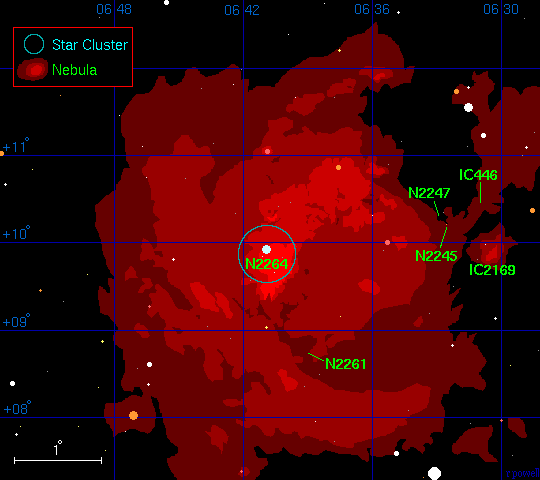
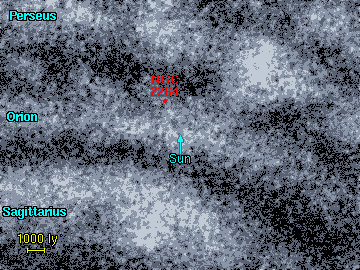
|
The distance to the Cone Nebula is well-known, because it has a cluster of stars at the centre of it. The distance is about 2200 light years which means the nebula is within the Orion Arm about 900 light years further from us than the Orion Nebula. |
| Right - a close-up view of the 'cone' in the Cone Nebula. This triangular nebula is probably caused by gas flowing outwards from young stars located near to the apex of the cone. | 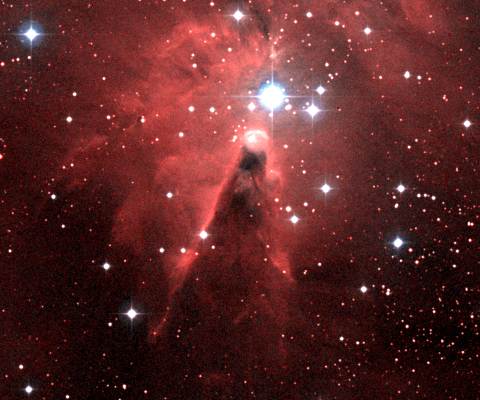 NGC 2264. Image size: 0.33°x0.28°. DSS image. |
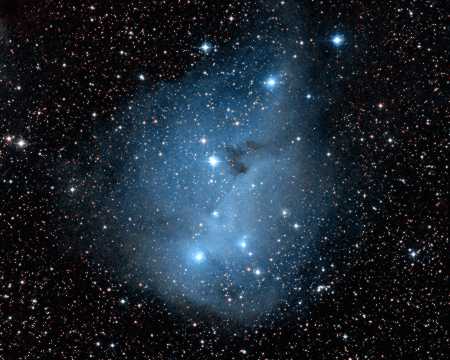 IC 2169. Image size: 0.66°x0.53°. DSS image. |
Left - the IC 2169 reflection nebula. Although this nebula is detached from the Cone nebula, it may be part of the same molecular cloud. This nebula is a typical example of a reflection nebula - the dust in the nebula scatters light from stars within the nebula and makes the nebula shine with a blue glow. |
| Right - Hubble's variable nebula. This small nebula around the star R Monocerotis probably lies behind the Cone nebula. This is a bipolar nebula - it is a very young star emitting two streams of gas. This nebula contains 'Herbig-Haro' objects - a glow caused by the streams of gas colliding with the surrounding interstellar medium. This nebula has a length of 3 light years. The nebula is variable in brightness because the star varies in brightness between magnitudes 9.3 and 14.0. | 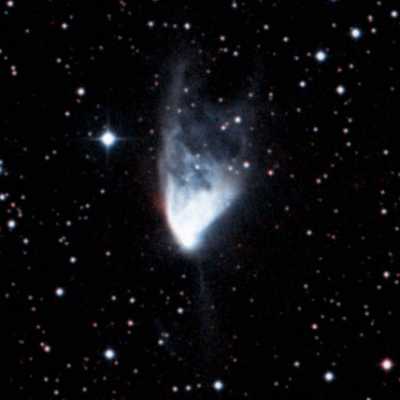 NGC 2261. Image size: 0.12°x0.12°. DSS image. |